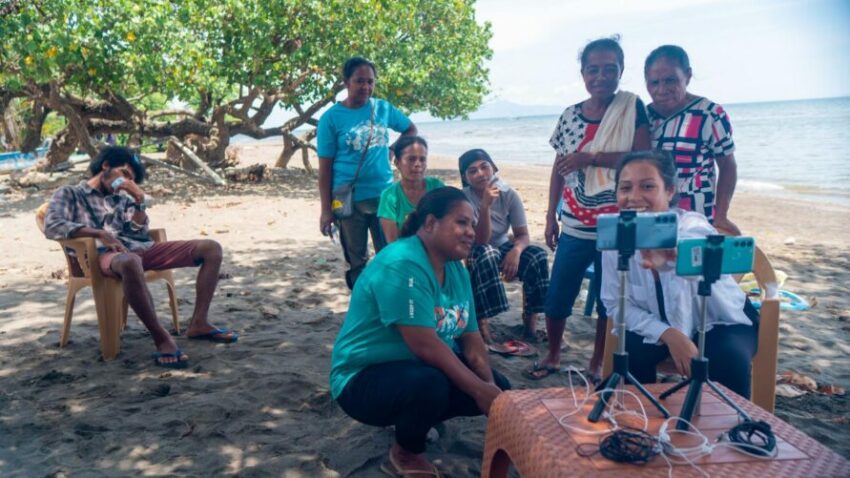There’s an abundance of climate solution stories this week from around the globe. As always, let us know what you would add to this inspiring list.
Designing solar parks that benefit local ecosystems, increase biodiversity
Hungarian solar company SolServices has published a comprehensive white paper in collaboration with national parks, environmental orgs, energy companies, and beekeepers that outlines ways to make solar farms more compatible with local ecosystems and that support native wildlife. The guide provides tools and practices for implementing solar projects that benefit pollinators, amphibians, birds, bats, rodents, and/or big game – taking the local ecological and biological features into account. “With proper design and minimal management and intervention, a solar park can provide an almost undisturbed habitat for both flora and fauna for some 30 years after construction.”
Rwandan eco-feminist empowers young climate leaders, wins Global Citizen Award
Ineza Umuhoza Grace is turning a generation of Rwandan youth into climate activists. She centers female, youth, and community-driven action to achieve climate justice. Grace is the co-founder and global coordinator of the Loss and Damage Youth Coalition – a coalition of 600+ youth from more than 60 countries taking concrete action to address loss and damage. She is also the founder and CEO of The Green Protector, a nonprofit working to increase youth participation in climate action that has reached more than 3,000 children and young people, implementing activities and engaging youth in climate policy negotiation on an international level.
Participatory video inspires community-led seagrass conservation in Timor-Leste
Local leaders and fishers in Timor-Leste organized community discussions around locally led marine management and the ecosystem services that seagrass meadows provide to coastal communities, utilizing participatory video and storytelling as a key advocacy tool. Participatory video is a set of techniques designed to involve a community in shaping their own film, intended to empower often underrepresented groups to identify and take action to solve their own problems and share ideas with decision-makers. The Timor-Leste project mapped seagrass meadows, brainstormed interventions to improve local fisheries, and inspired local action at a time when fishers were in a state of inertia following severe flood damage, falling fish catches, and a lack of alternative livelihoods.
Free AI platform makes bioacoustics data more accessible
Bioacoustics has transformed research efforts by enabling noninvasive monitoring of biodiversity, but the AI and machine learning that make the data analysis more efficient requires a hefty budget and technical expertise. Conservation technology nonprofit Rainforest Connection has developed a solution in Arbimom, a free online audio analysis platform that makes bioacoustics easier and more accessible, and bridges the gap between scientific research and conservation on the ground.
Caribou recovery in British Columbia highlights Indigenous-led stewardship
Salteau and West Moberly First Nations are leading efforts to recover caribou so they can reinstate ecological connections and cultural traditions of meaningful caribou hunting. While other herds decline, the Klinse-Za mountain caribou began to rebound from 16 animals in 2013 to 101 in 2021, and more recently, 114 caribou. A conservation partnership agreement between the First Nations and the Canadian government protects more than 8000 square kilometers of critical caribou habitat and highlights the role of Indigenous stewardship and leadership in endangered species recovery.
Ukraine’s green reconstruction plans include “circular” building designs
Ukrainian scientists, architects, and urban planners are pushing for a postwar recovery that focuses on climate resilience, clean energy, and sustainable design – potentially a global template for climate-friendly postwar recovery. The Ro3kvit Urban Coalition for Ukraine has carried out research on forms of emergency housing and “circular” rebuilding, including using rubble to repair damaged structures. The group is envisioning new districts in impacted cities like Mariupol and Zaporizhzha to accommodate larger numbers of internally displaced people, enhance public safety and urban ecology, as well as train Ukrainian mayors and local officials in sustainable reconstruction techniques.
Additional Solution Stories to Consider…
- Nonprofit org Camino Verde has collaborated with more than 100 Amazonian families from five native communities to restore Peruvian forests through diverse polyculture agroforestry programs.
- The A’i Kofán de Sinangoe Indigenous guard in the Ecuadorian Amazon is using georeferencing tools, drones, and solar-powered camera traps to protect forests from illegal logging.
- Agroecology and agroforestry are helping residents of Kiday in the Philippines rebuild community and ancestral traditions after flood devastation.
- Paying landowners to regrow degraded forests and maintain existing forests brings significant economic and environmental benefits in the Osa Peninsula in Costa Rica.
- A heritage seed saving effort in Ireland supports an agroecological approach to land management, climate resilience, and food sovereignty in rural communities.

